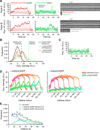Advances in analysis of low signal-to-noise images link dynamin and AP2 to the functions of an endocytic checkpoint
- PMID: 23891661
- PMCID: PMC3939604
- DOI: 10.1016/j.devcel.2013.06.019
Advances in analysis of low signal-to-noise images link dynamin and AP2 to the functions of an endocytic checkpoint
Abstract
Numerous endocytic accessory proteins (EAPs) mediate assembly and maturation of clathrin-coated pits (CCPs) into cargo-containing vesicles. Analysis of EAP function through bulk measurement of cargo uptake has been hampered due to potential redundancy among EAPs and, as we show here, the plasticity and resilience of clathrin-mediated endocytosis (CME). Instead, EAP function is best studied by uncovering the correlation between variations in EAP association to individual CCPs and the resulting variations in maturation. However, most EAPs bind to CCPs in low numbers, making the measurement of EAP association via fused fluorescent reporters highly susceptible to detection errors. Here, we present a framework for unbiased measurement of EAP recruitment to CCPs and their direct effects on CCP dynamics. We identify dynamin and the EAP-binding α-adaptin appendage domain of the AP2 adaptor as switches in a regulated, multistep maturation process and provide direct evidence for a molecular checkpoint in CME.
Copyright © 2013 Elsevier Inc. All rights reserved.
Figures







References
-
- Conner SD, Schmid SL. Regulated portals of entry into the cell. Nature. 2003;422:37–44. - PubMed
Publication types
MeSH terms
Substances
Grants and funding
LinkOut - more resources
Full Text Sources
Other Literature Sources
Molecular Biology Databases
Research Materials

